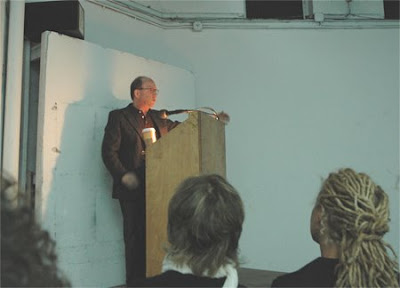
Jerry Saltz's lecture at the New York Studio School, April 22, 2009
A few days ago, Emily Amy Gallery artist Sarah Hinckley, sent me a link to Hrag Vartanian's response to Jerry Saltz' recent lecture at the New York Studio School entitled, "This is the End; The Rising Tide that Floated All Boats has Gone Out and All Boats are in Danger of Sinking." Although a somewhat comical and certainly long-winded lecture title, the talk (aptly called "This is the End..." by many) has made major headlines and hit home across the art world in New York City and beyond. A long-time critical voice in the New York arts scene (writing for the Village Voice for 9 years and New York Magazine since 2007), Saltz is well-known for his reviews of exhibitions--sometimes raving, but often censorious. In his recent lecture, Saltz discussed and criticized the cycle that has occurred in the last 15 years in the "business" that is art. As to its current state, Hrag summarizes, "The verdict: who knows, and anyone that tells you otherwise is lying."
Although as a gallery owner I would like to say that this statement is completely untrue and everything is currently on the "up and up", I am in fact unsure. I have experienced increased traffic at the openings, excitement for the
Westside Arts 3rd Saturday Art Walks, and an increase in sales since 2008, but as for the future, I can only speculate.
In his lecture, Saltz points to many problems for the art world's recent demise, namely the plethora of over-academicized curators and critics that favor "late late late late conceptualism." Saltz explains, "In the art world, the pleasure police came in, and sterility reigned." He also cites the over-heated market and the "feeding frenzy" that is the art fair as capitalism and consumption gone completely awry. He goes so far as to pinpoint that instead of the art market being so clever that curators and gallerists would only show the best work, in actuality, "the art market is so dumb that it buys anything other people are buying." He goes on to state that this has led to the dominance of very few styles and the "celebrity" of four artists, in particular: Damien Hirst, Jeff Koons, Takashi Murakami, and Richard Prince. Though this has been the norm in the past...the times they are a changin'.
Saltz concludes by indicating that the new art world, "will be something we won't recognize and will be dominated by names we don't know today." Saltz rallies for a new plurality of the art world and buying art for more than just a financial investment. And, although we are all venturing into unchartered territory, since "buy what you love" has always been my philosophy, I have to say, I am feeling pretty good about where we are headed.



















